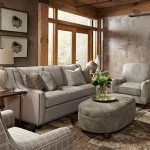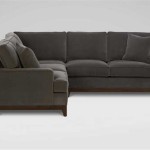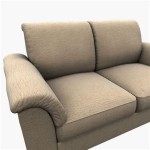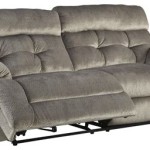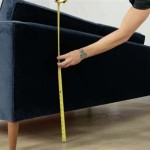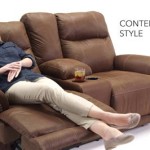Low Back Sofa: A Comprehensive Overview
The low back sofa, characterized by its shorter backrest height compared to traditional sofas, represents a significant design choice within the realm of seating furniture. Its aesthetic and functional properties contribute to its popularity in contemporary interiors. This article will explore the defining features of low back sofas, their advantages and disadvantages, considerations for choosing the right model, the diverse range of styles available, and their compatibility with various design schemes.
The defining characteristic of a low back sofa is, as the name suggests, its reduced backrest height. This dimension typically measures below the shoulder blades of a seated individual, offering a different level of support compared to sofas with higher backs. This design choice directly impacts the overall visual profile of the sofa, contributing to a more open and less obstructive feel within a room. The lower profile can also facilitate better sightlines and a greater sense of spaciousness, particularly in smaller living areas.
The construction materials used in low back sofas are diverse, mirroring the broader sofa market. Frames are typically constructed from hardwoods such as oak or maple, or engineered woods like plywood. These materials provide the necessary structural support and durability. Upholstery options range from natural fibers like cotton, linen, and wool to synthetic materials such as polyester and microfiber. Leather, both genuine and faux, is also a popular choice, offering a luxurious aesthetic and durability. The internal cushioning is generally composed of foam, feathers, or a combination of both, influencing the sofa's comfort level and overall feel.
Key Point 1: Advantages of Low Back Sofas
Low back sofas offer several advantages that contribute to their appeal. One of the primary benefits is their aesthetic impact on a room. The lower profile allows for a more open and airy feel, preventing the sofa from dominating the space visually. This is particularly advantageous in smaller apartments or living rooms where maximizing the sense of space is crucial.
Furthermore, low back sofas often promote better communication and interaction within a room. Because the backrest doesn't obstruct the view, individuals seated on the sofa can easily engage in conversations with others in the room. This can create a more social and inclusive atmosphere. This design characteristic is also beneficial for interior design layouts where clear sightlines are desired, such as spaces with architectural features or artwork that should remain visible.
Another advantage lies in their versatility. Low back sofas can complement a variety of interior design styles, from minimalist and modern to bohemian and eclectic. Their streamlined silhouette allows them to blend seamlessly with different decor elements and color palettes. They are also often easier to move and rearrange compared to larger, bulkier sofas, providing greater flexibility in room layout.
Finally, the price point can sometimes be an advantage. While high-end low back sofas can be quite expensive, entry-level models may be more affordable than comparable sofas with higher backs due to the reduced material required for the backrest construction.
Key Point 2: Disadvantages and Considerations
Despite their advantages, low back sofas also present certain drawbacks that potential buyers should consider. The most significant disadvantage is the limited back support they provide. The shorter backrest may not adequately support the upper back and shoulders, potentially leading to discomfort for individuals who require more substantial lumbar support. This can be mitigated by using additional cushions or pillows, but it is a factor to consider for individuals with back problems or those who prefer a more supportive seating experience.
Another consideration is the potential for a more casual or informal aesthetic. While this can be a stylistic advantage in some settings, it may not be suitable for more formal or traditional living rooms. The low back can create a more relaxed and less structured appearance, which may not align with all design preferences.
Furthermore, the limited back height can impact the overall comfort level for taller individuals. The shorter backrest may not provide adequate support for the head and neck, potentially causing strain or discomfort during extended periods of sitting. This is particularly relevant for individuals who frequently use the sofa for activities such as reading or watching television.
Finally, the reduced back height can sometimes make the sofa appear smaller than it actually is. This can be a disadvantage in larger rooms where a more substantial piece of furniture is needed to anchor the space. Careful consideration of the sofa's dimensions and proportions is essential to ensure that it is appropriately scaled to the room.
When selecting a low back sofa, it is crucial to prioritize comfort and support. Test-sitting is highly recommended to assess the level of back support and overall comfort. Paying attention to the depth of the seat, the firmness of the cushions, and the quality of the upholstery is also essential. Considering the intended use of the sofa and the individual needs of the users will help ensure that the chosen model provides an adequate level of comfort and support.
Key Point 3: Styles and Design Compatibility
Low back sofas are available in a wide range of styles, allowing them to seamlessly integrate into diverse design schemes. Mid-century modern low back sofas, characterized by clean lines, tapered legs, and minimalist silhouettes, are a popular choice for contemporary interiors. These sofas often feature natural wood frames and neutral-toned upholstery, reflecting the aesthetic principles of the mid-century modern era.
Contemporary low back sofas often incorporate sleek lines, geometric shapes, and a focus on functionality. These models may feature features such as built-in USB ports or adjustable headrests. Upholstery options include a variety of fabrics and colors, offering a wide range of design possibilities.
Bohemian-style low back sofas often feature plush cushions, textured fabrics, and a relaxed silhouette. These sofas may be adorned with decorative pillows, throws, and other embellishments to create a comfortable and inviting seating area. Earthy tones and natural materials are commonly used to enhance the bohemian aesthetic.
Minimalist low back sofas are characterized by their simplicity, clean lines, and lack of ornamentation. These models often feature a streamlined silhouette and neutral-toned upholstery, reflecting the principles of minimalist design. The focus is on functionality and creating a clutter-free environment.
Low back sofas can be effectively integrated into various design schemes by carefully considering the surrounding decor and furniture. In minimalist interiors, a low back sofa with clean lines and neutral upholstery can create a cohesive and understated look. In bohemian interiors, a low back sofa with plush cushions and textured fabrics can add warmth and character to the space. In contemporary interiors, a low back sofa with sleek lines and geometric shapes can complement the modern aesthetic.
The choice of accessories can also significantly impact the overall look and feel of a low back sofa. Adding throw pillows in complementary colors and patterns can enhance the sofa's visual appeal and provide additional comfort. Throw blankets can add warmth and texture, while coffee tables and side tables can provide functional surfaces for drinks and other items. The placement of artwork, lamps, and other decorative objects around the sofa can further enhance the overall design scheme.
Ultimately, the selection of a low back sofa should be based on a careful consideration of individual needs, design preferences, and the overall aesthetic of the room. While the reduced back height may not be suitable for everyone, it offers a unique design element that can enhance the visual appeal and functionality of a living space.
The size and scale of the low back sofa must be proportional to the room it occupies. In a small apartment, a compact low back sofa can maximize space and prevent the room from feeling crowded. In a larger living room, a larger low back sectional sofa can provide ample seating and create a more inviting atmosphere. Measuring the room and carefully considering the sofa's dimensions are essential steps in the selection process.
The durability of the sofa's construction is another crucial factor to consider. Opting for a sofa with a solid hardwood frame and high-quality upholstery will ensure that it can withstand everyday wear and tear. Reading reviews and researching the manufacturer's reputation can provide valuable insights into the sofa's durability and longevity.
The color and pattern of the upholstery should complement the existing color palette of the room. Neutral tones, such as gray, beige, and white, are versatile options that can easily blend with different decor styles. Bold colors and patterns can add a pop of personality and visual interest to the space, but they should be chosen carefully to avoid clashing with other elements in the room.
Regular maintenance and cleaning are essential for preserving the appearance and lifespan of a low back sofa. Vacuuming the sofa regularly can remove dust and debris, while spot cleaning can address spills and stains. Following the manufacturer's instructions for cleaning and care will help ensure that the sofa remains in good condition for years to come.

Comparing The Pros And Cons Of High Back Sofas Low Picket Rail Custom Furniture Interiors

Buy Sofa Singapore Blok Fabric Nook And Cranny

Buy Sofa Singapore Blok Fabric Nook And Cranny

The Low Back Sofa For Superior Comfort Thomas Lloyd

Low Back Leather Sofa Reverse Seam Drake Mobilia
Low Back Sofas Sterling Home

Wow Low Back Sectional Sofa Bello Spazio

Air Low Back Sofa Furniture Home Living Sofas On Carou

Scandinavian Living Room Low Back Sofa Decor
Low Back Sofas Sterling Home

